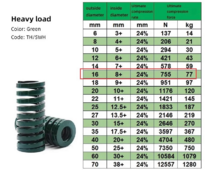hardtop
New Member
Springs would make sense to me only to unload pressure so that cell compression doesn't exceed maximum pressure.
Springs would make sense to me only to unload pressure so that cell compression doesn't exceed maximum pressure.
.....Spring? And a big of mathematics? I am using four of this springsI’m soon going to be putting into service a new 8 pack of LF304K cells, so trying to get up to speed with compression mounts. It’s not so easy with so many threads and posts about cell compression and differing opinions!
I have in fact already made a mount using M8 threaded rod and fixed end plates, no springs. If I have interpreted things correctly the procedure should be to get the cells discharged to a low state of charge (under 3V per cell?) then apply a 300kg force by tightening nuts on the m8 threaded rods and after that just lock the nuts with threadlock compound or locknuts and leave it alone?
Then the question is, how on earth do you know how to achieve 300kg with m8 nuts on threaded rod? Is there a rule of thumb for how many turns past finger tight, for example?

Thanks, but I don’t really want the complication of adding springs - plus my M8 threaded rod which I already cut is not going to be long enough for springs. I prefer to just tighten down my thick end plates to around the right compression but am clueless about how to judge this!.....Spring? And a big of mathematics? I am using four of this springs
View attachment 216121
I think with the eves you would compress them at the charge level they were delivered at. if you do the initial compression with them at low soc then once they get a full charge you may end up over compressing.I’m soon going to be putting into service a new 8 pack of LF304K cells, so trying to get up to speed with compression mounts. It’s not so easy with so many threads and posts about cell compression and differing opinions!
I have in fact already made a mount using M8 threaded rod and fixed end plates, no springs. If I have interpreted things correctly the procedure should be to get the cells discharged to a low state of charge (under 3V per cell?) then apply a 300kg force by tightening nuts on the m8 threaded rods and after that just lock the nuts with threadlock compound or locknuts and leave it alone?
Then the question is, how on earth do you know how to achieve 300kg with m8 nuts on threaded rod? Is there a rule of thumb for how many turns past finger tight, for example?
Any online sources for PORON EVExtend 71? It seems more compliant versus laminate sheets/cutting boards etc, to avoid pressure hotspots from non uniformities in the cell faces?I am not a fan of springs. You would need to use flexible braided cell interconnects to allow cells terminals to move together with cell expansion. Much better to use battery foam sheets to let cells expand in place without relative movement.
I bought foam sheets of similar properties: PORON 4701-40 Foam W/Adhesive Backing - 12.375" x 9.375" x 0.125" - Box of 10.Any online sources for PORON EVExtend 71? It seems more compliant versus laminate sheets/cutting boards etc, to avoid pressure hotspots from non uniformities in the cell faces?
I’m soon going to be putting into service a new 8 pack of LF304K cells, so trying to get up to speed with compression mounts. It’s not so easy with so many threads and posts about cell compression and differing opinions!
I have in fact already made a mount using M8 threaded rod and fixed end plates, no springs. If I have interpreted things correctly the procedure should be to get the cells discharged to a low state of charge (under 3V per cell?) then apply a 300kg force by tightening nuts on the m8 threaded rods and after that just lock the nuts with threadlock compound or locknuts and leave it alone?
Then the question is, how on earth do you know how to achieve 300kg with m8 nuts on threaded rod? Is there a rule of thumb for how many turns past finger tight, for example?
Not using springs in compression fixture. Just using yellow pine wood 1 inch x 10 inch cut to length and four 1/4 inch course threaded rods with 1/4 inch nuts & washers on the 8s Lifepo4 battery banks.
This is Info I used and torqued a little less at 5 Inch Pounds with a torque wrench at about 3.2 to 3.3 volts charge in each cell.
The spec from EVE was 300 KG force which rounds off to 660lbs. Battery face is approx 6.85"x 7.874" = 53.94 sq inches
660lbs/53.94sqin=12.23 lbs per sq inch
Divide 660 by 4 bolts that's 165 lbs Axial (clamping) force per bolt.
Using 4 course 1/4 in threaded rods that should equate to roughly 8 INCH pounds torque per bolt. Realistically, that's a snug twist of the wrist on a regular nut driver for the average build mechanic.
Hope it helps...


